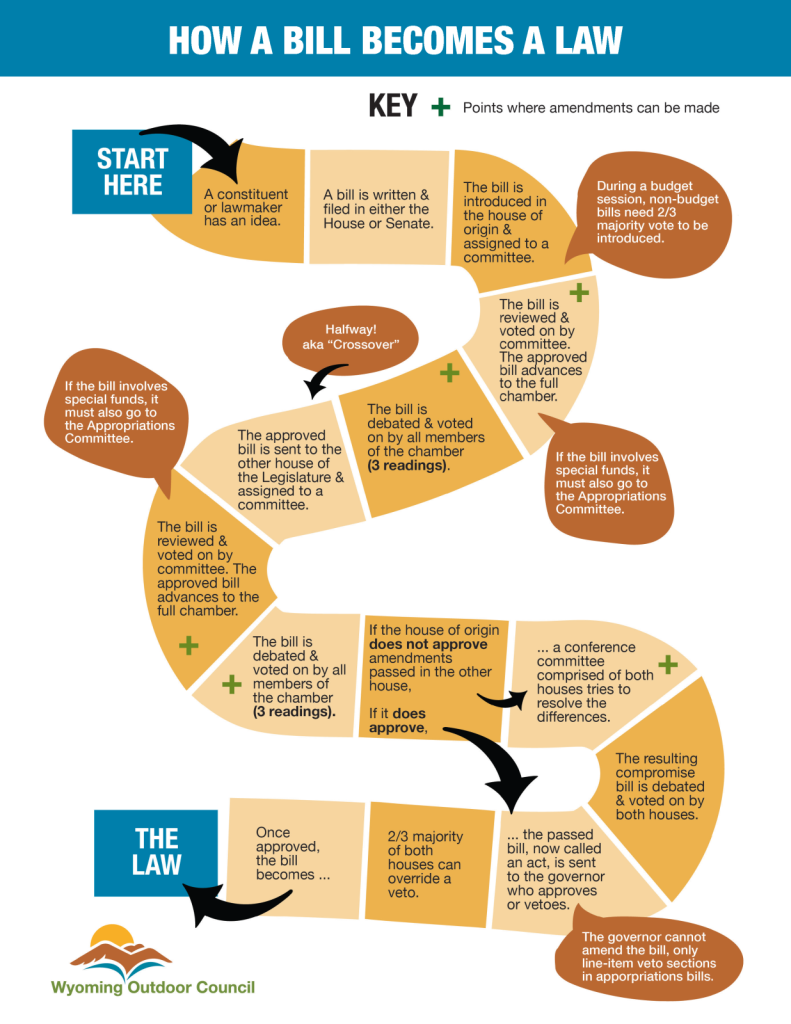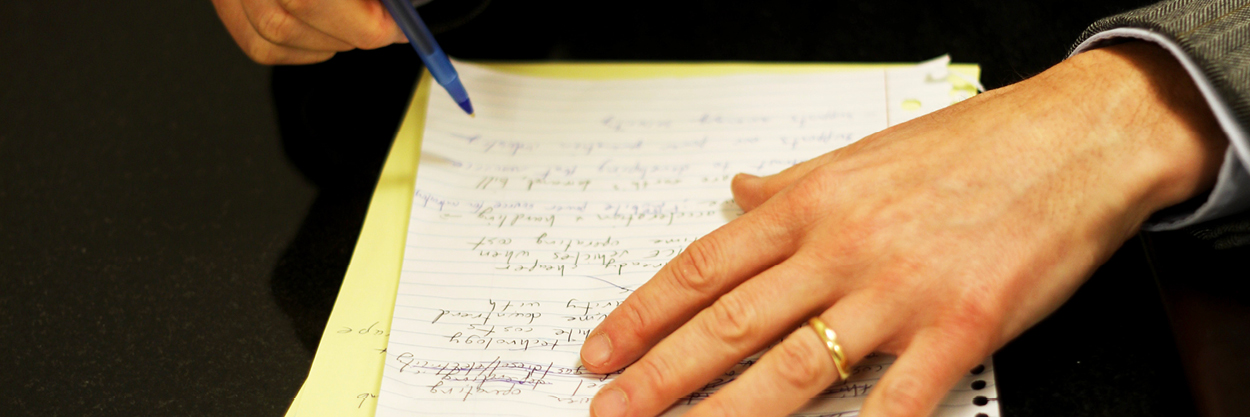For me, today’s not just another Monday. It’s the kickoff to the budget session of the 67th Wyoming Legislature — a day that’s been circled in big, bold strokes on my calendar for months.
So what will happen, you ask, on this Not-Just-Any-Monday?
Let’s start with what we know: When this email reaches your inbox, I’ll be on my way to the Capitol. At 10 a.m., Gov. Mark Gordon will deliver his State of the State address to the House and the Senate. And at 2 p.m., both chambers will hold opening ceremonies before beginning their discussions on the many, many non-budget bills on the docket.
We know that many of those bills will die before the week is out, because they won’t reach the two-thirds majority required to be introduced before Friday’s deadline.
Finally, we know that I (along with WOC program director Alec Underwood and energy and climate policy director John Burrows) will do plenty of racing through the halls as we track the conservation-related bills we’ve prioritized. Keep an eye on our bill tracker to follow along as we monitor, support, oppose, and suggest amendments to these bills.
There’s still plenty we don’t yet know, and won’t know, until the end of this week — like which bills will die before they see the light of day and what new bills lawmakers will publish before the window for new legislation closes on Wednesday. It’s what we don’t yet know that will make this week so dynamic and action-packed.
Today we’ll begin by diving into uncertainty, but as the days unfold, we’ll know more and more — and our priorities will become clearer. Every step of the way, our bill tracker will provide updated information about which bills have died and where the rest of them are in the process.
That process isn’t the most straightforward thing in the world, so we’ve included a helpful guide to the journey from bill to law below. It’ll help you get the most out of our bill tracker, so it’s worth a look!

As the session progresses, you’ll hear us note where bills of interest are on their road to becoming law. This infographic lays out the entire process! But here’s a little more detail.
The Speaker of the House or President of the Senate picks the order of bills to be introduced to their respective chambers. Introduction is the First Reading of a bill.
During this year’s budget session, a bill must pass a two-thirds majority vote to be introduced. (This step is skipped in a General Session.) If the bill passes the introductory vote, the Speaker or President then assigns it to a Standing Committee.
The Committee Chair determines when, or even if, a bill will be heard by the committee. If it is heard, the committee reviews the bill, hears input from the public, considers amendments, and votes on if or how to recommend the bill to the full chamber.
If the bill moves out of committee, it is then placed on General File. This “file” is where bills wait before they are debated by the entire House or Senate. The Majority Floor Leader decides the order of bills on General File. They (like committee chairs and the Speaker or President) can work to keep a bill from being discussed by keeping it at the end of the list.
The Committee of the Whole is the entire chamber (House or Senate). The Committee of the Whole debates the bill and decides whether to support or reject the recommendation from the committee, or to amend it. If a majority votes to support the bill, it then moves to Second Reading, where it can be amended and/or voted on again. Unless there is an amendment, this step is expedited by putting the bill on a Consent List where it is voted on as a package with other bills. Any legislator can ask that a bill be removed from the consent list, discussed, and voted on separately. (Introduction and Third Reading votes may also be expedited by utilizing consent lists as well.)
Each bill has a Third Reading where it can again be amended before being voted upon. If it passes, all amendments are engrossed, which means they are added to the bill before it moves to the other chamber. This whole process, from Introduction to Third Reading, is then repeated in the other chamber.
If the bill is amended in the second chamber, the first chamber may agree with these changes, or not. If not, it is sent to a Conference Committee. This committee is made of members of both chambers. They attempt to work out the differences between the bills and create a version that both chambers can approve.
Once both chambers agree on the same version of a bill, it is then enrolled and sent to the governor. The governor can sign it into law, let it become law without his signature, or veto it. The legislature can override a veto with a two-thirds majority of both chambers.
The bill then takes effect on the effective date.
It’s important to remember that the budget bill follows a different process. For more on the budget process, see our blog about demystifying Wyoming’s budget.
Follow the action
All floor proceedings and committee meetings during the 2024 Budget Session will be broadcast live via the Wyoming Legislature’s YouTube channel. That’s also where recordings (of this session as well as past sessions) can be found.
Find our bill tracker
Get the latest information on the bills we support and oppose with WOC’s bill tracker on our State Legislature webpage. Learn about the bills we’re tracking and where they are in the journey from bill to law.
Get your lobbying skills in tip-top shape
Are you looking to deepen your grassroots lobbying skills? It’s not too late to sign up for the Equality State Policy Center’s free SHAPE training, which takes place virtually next week. (You might just get hooked … In fact, this is how Era got her first taste of the legislative process years ago!)
The Wyoming Outdoor Council is a coalition member of ESPC.
Capitol collaborations
ESPC, along with the Wyoming Independent Citizens Coalition and the Wyoming Civic Engagement Network, invite you to Capitol Collaborations, an event to bring together the vibrant Latino and Hispanic communities in Wyoming at the Capitol. This free event includes a tour of the Capitol and a chance to learn more about the state’s legislative process. Capitol Collaborations will happen March 1. Details and registration HERE.
Thanks for asking!
In last week’s Legislative Lowdown, we demystified the state budget and budget process. We received this follow-up question in response.
Q: You’ve said the budget impacts conservation by distributing funding to agencies such as the DEQ and Wyoming Energy Authority … but what about Game and Fish?
Wyoming Game and Fish Department’s budget is not part of the general budget bill or the broader state budget process. They do not receive State General Funds, and instead generate their own revenue.
Keep the questions coming! To learn more about Wyoming’s budget process, be sure to visit last week’s Lowdown.
One last thing: During this busy first week, chances are good we’ll call on you to voice your support for good bills, or help stop bad bills in their tracks. So keep an eye out for action alerts in your email inbox and on our social media. (Here’s our Instagram and Facebook.) You can also find plenty of advocacy tools on our State Legislature page. Thank you in advance for speaking up for conservation.
To borrow a phrase from my other role, on my county’s Search and Rescue team, onward into the fog!

